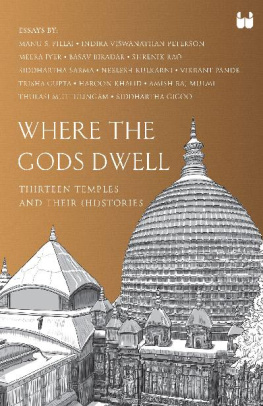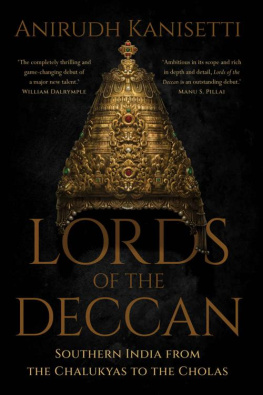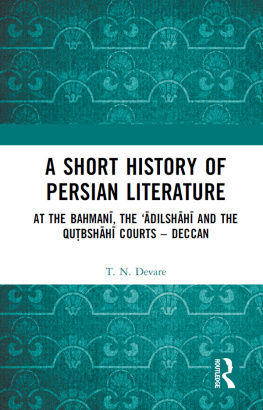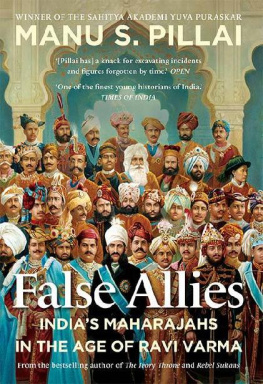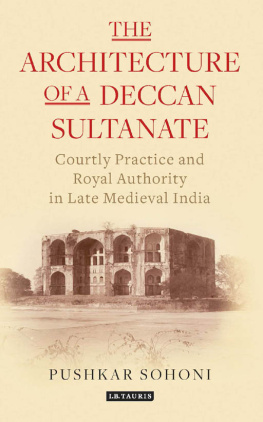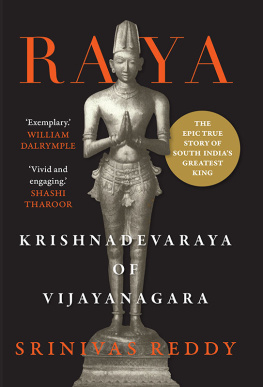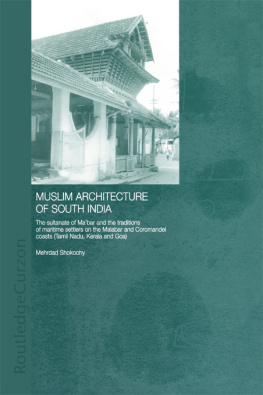
Preface
Chronology of the principal events mentioned in this book
1206: Founding of the Delhi Sultanate
1296: Alauddin Khiljis triumph over the Yadavas of Devagiri
1308: Second invasion of Devagiri by Malik Kafur
1310: Malik Kafurs triumph over the Kakatiyas of Warangal
1311: Malik Kafurs triumph over the Hoysalas of Dwarasamudra
1313: Annexation of Devagiri by Malik Kafur
1318: Rebellion of Prataparudra of Warangal quashed
1320: Rise of the Tughluq dynasty in Delhi
1321: Defeat of Sultanate forces at Warangal
1323: Prataparudra is defeated and Warangal is annexed
1325: Muhammad bin Tughluq becomes Sultan
1327: Daulatabad (formerly Devagiri) named capital of the Tughluqs
1335: Tughluqs resume ruling from Delhi
1336: Harihara I, son of Sangama, launches the Vijayanagar empire
1342: The last Hoysala sovereign is hanged in Madurai
1345: Amirs of the Deccan rebel against the Tughluqs
1346: Sangama brothers celebrate their conquests in the south
1347: Hasan Gangu crowned first Bahmani Sultan in Daulatabad
1347: Gulbarga becomes the Bahmani capital
1347: Sangama brothers first start using the title Sultan among Hindu Kings
1351: Death of Muhammad bin Tughluq
1356: Death of Harihara I in Vijayanagar
1358: Death of Hasan Gangu
1363: Kapaya Nayaka presents the Bahmani Sultan the Turquoise Throne
1370: Vijayanagar annexes the short-lived Madurai Sultanate
1378: Bahmanis are defeated by Vijayanagar; a Sultan is murdered
1397: Firoz Shah Bahmani prevails at court and becomes Sultan
1406: Firoz Shah marries a Vijayanagar princess after a military victory
1418: Defeat of the Bahmanis by Vijayanagar
1422: Firoz Shah dies and Ahmad Shah becomes Sultan
1425: Devaraya II succeeds in Vijayanagar and opens an age of glory
1427: Bahmani Sultanate moves its capital to Bidar
1430: Vijayanagar absorbs large numbers of Muslim cavalrymen
1443: Assassination attempt against Devaraya II
1445: Abdur Razzak Samarqandi visits Vijayanagar as ambassador of the Persian Shah
1446: Death of Devaraya II; a slow crisis begins in Vijayanagar
1453: Mahmud Gawan arrives in the Deccan from Persia
1460: Arrival from Persia of the future Yusuf Adil Shah
1463: Mahmud Gawan becomes premier of the Bahmani Sultanate
1470: Sultan-Quli, the future Qutb Shah of Golconda, arrives in the Deccan
1472: Mahmud Gawan captures Goa
1481: Execution of Mahmud Gawan; decline of the Bahmanis begins, the Sultan politically emasculated
1485: Fall of the Sangama dynasty and rise of Saluva Narasimha in Vijayanagar
1489: Bidar comes under the Barid Shahs; the Bahmani Sultan made their puppet
1490: Nizam Shahi founded in Ahmadnagar
1490: Adil Shahi founded in Bijapur
1490: Imad Shahi founded in Berar
1502: The Adil Shah declares his state a Shia polity
1505: Tuluva dynasty (the Third dynasty) seizes power in Vijayanagar
1505: Vijayanagar proposes a marital alliance with the King of Portugal
1509: Krishnadeva becomes Raya of Vijayanagar and launches a second golden age
1510: The Adil Shah loses Goa to the Portuguese
1518: The Qutb Shah in Golconda becomes independent of the nominal sovereignty of the Bahmani Sultan
1520: Krishnadeva conquers Raichur from the Adil Shah
1523: Krishnadeva assumes the title of Restorer of Turkish Power
1524: The Adil Shah and Nizam Shah seal a marital alliance but feud over territory
1526: Fall of the Delhi Sultanate and the rise of the Mughal empire in upper India
1527: The last Bahmani Sultan, Kalimullah, appeals to Mughal emperor Babur for help
1528: Kalimullah escapes Bidar and goes into exile in Ahmadnagar
1529: Krishnadeva dies in Vijayanagar; a period of crisis begins
1530: The Adil Shah resumes control of Raichur
1538: Kalimullah dies and the powerless Bahmani dynasty comes to an end
1542: Ramaraya becomes regent of Vijayanagar and centralizes power in himself
1543: Sultan Quli-Qutb Shah is assassinated; Jamshid becomes ruler; his brother Ibrahim goes into exile in Vijayanagar
1543: Miyan Ali of the Adil Shahi family goes under Portuguese protection
1545: Garcia da Orta comes to the Nizam Shahs court
1550: Jamshid dies and Ibrahim becomes the Qutb Shah in Golconda
1553: Husain Nizam Shah succeeds to the throne in Ahmadnagar
1555: Miyan Alis attempt to seize the Adil Shahi throne with Portuguese aid fails
1558: Ali Adil Shah I comes to power in Bijapur and forms an alliance with Ramaraya of Vijayanagar against the Nizam Shahs
1561: Husain Nizam Shah sues for peace with Vijayanagar and the Adil Shah but resolves to fight again another day
1562: Ramaraya becomes de facto emperor in Vijayanagar
1564: The Qutb Shah, Adil Shah and Nizam Shah ally through marriage and form a league against Vijayanagar
1565: Vijayanagar is destroyed after the Battle of Talikota; Ramaraya is killed
1570: The famous Nujum al-Ulum is produced at the Adil Shahi court
1571: Malik Ambar arrives as a slave in the Deccan
1574: The Nizam Shahs conquer Berar and the dynasty of the Imad Shahs ends
1580: Ali Adil Shah is succeeded by Ibrahim Adil Shah II; Chand Bibi becomes regent
1582: Chand Bibi retires to the Nizam Shahi court at Ahmadnagar
158891: Succession disputes and rivalries in Ahmadnagar; a Nizam Shah is assassinated
1589: The chronicler Ferishta arrives at the Adil Shahi court in Bijapur and writes his history
1591: Mughal Emperor Akbar turns his attention to the Deccan; a new Nizam Shah succeeds in Ahmadnagar
1591: The Qutb Shahs establish the city of Hyderabad outside Golconda
1595: The Nizam Shah dies and Ahmadnagar descends into factional chaos after the brief reign of a half-African Nizam Shahi prince
1595: Mughals lay siege to Ahmadnagar; Chand Bibi defends the city and terms are agreed
1596: Farrukh Beg, the painter, commences his thirteen-year stay at the Adil Shahi court
1597: Chand Bibi, with the Qutb Shah and Ibrahim Adil Shah II, fight the Mughals but the allies are defeated
Next page

